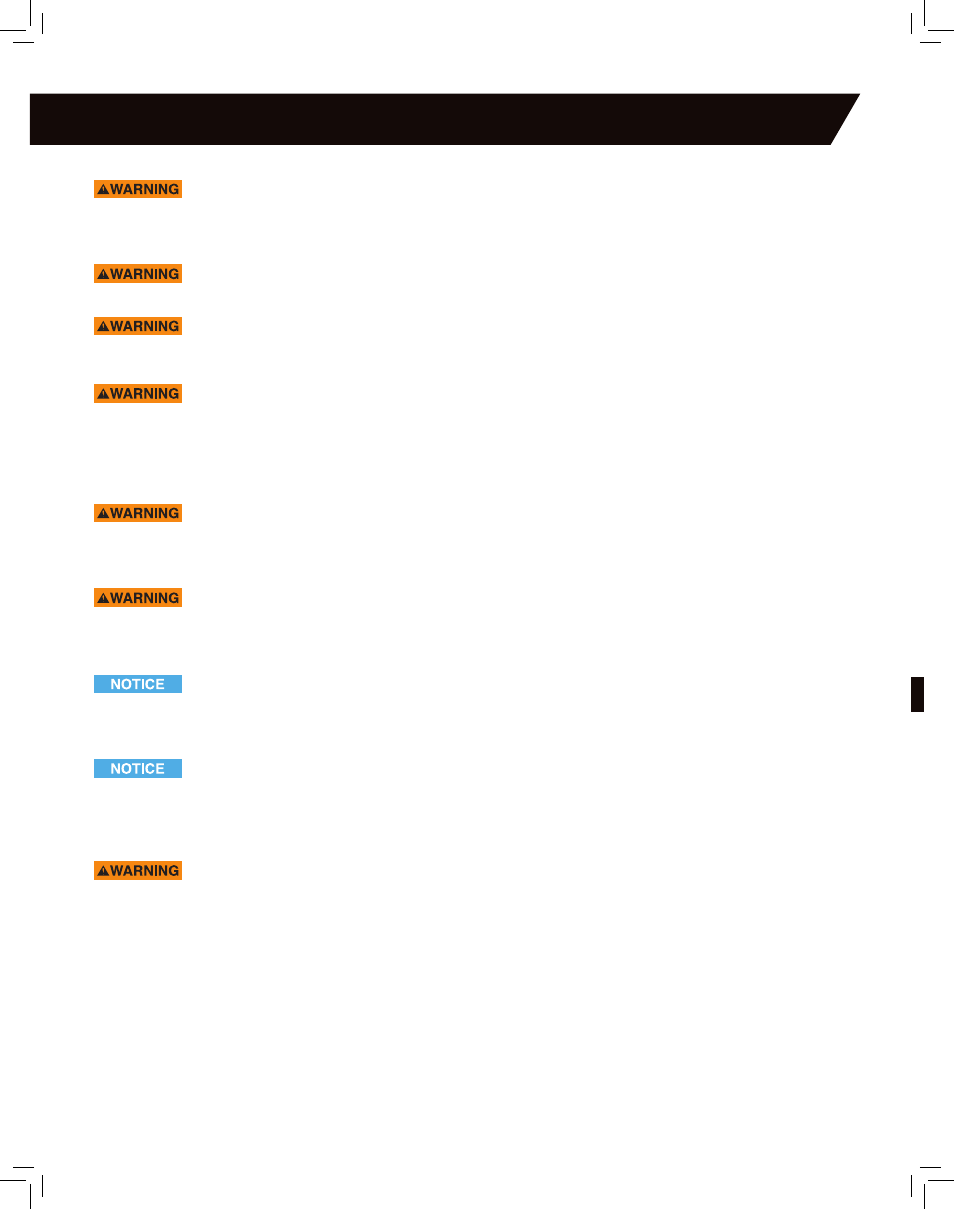Preventive maintenance & care of your crossbow – Horton General Crossbow User Manual
Page 12

12
PREvENTIvE MAINTENANCE & CARE
OF YOUR CROSSBOW
MAINTENANCE WARNINGS
Wear safety glasses when servicing or
maintaining your crossbow to protect your
eyes from being injured if the limbs were to shatter and/or the
bowstring, cables, or cocking unit cords were to break.
Your crossbow must be uncocked and unloaded
before conducting any maintenance on it.
Do not modify your crossbow or remove or
deactivate its safety features because this could
cause it to malfunction and create a dangerous situation.
Do not attempt to adjust your crossbow’s draw
weight or to change its cables, limbs, or string
because improper installation or adjustments could cause it to
malfunction and create a dangerous situation. Have a qualified
professional with the proper training and tools perform
these tasks.
Carefully examine your crossbow for worn, loose,
damaged, or missing parts every time before you
use it. A damaged crossbow, or one in need of maintenance or
repair, could be dangerous to you or others.
Do not use your crossbow if it is not in top
working condition because equipment failure
could cause injury to you or bystanders. Contact Customer
Service.
Do not apply string wax to the center serving,
barrel or trigger because the wax will collect
inside the trigger mechanism and eventually prevent the string
from latching properly.
Do not use heavy oil, grease, or substances
similar to petroleum jelly because they will
attract dust and grit that will work their way into the trigger
housing, making it sluggish and possibly inoperable in
cold weather.
Do not cock your crossbow if the bowstring or
cables are worn or frayed because they could
break resulting in serious personal injury.
MAINTENANCE PROCEDURES
The best maintenance program begins by thoroughly checking for
worn, loose, damaged or missing parts
every time you use
your crossbow.
1. Immediately replace frayed or worn strings and cables:
Keep your strings and cables moist and extend their life
with a high-quality string wax such as Horton’s String Wax &
Conditioner (HCA-11015-H). Do not apply string wax to the
center serving, barrel or trigger – the wax will collect inside
the trigger mechanism and eventually prevent the string from
latching properly.
Note: Horton recommends changing both
string and cables every other year under normal hunting/
shooting conditions.
2. General Lubrication:
• Use a high quality barrel or rail lubricant such as Horton’s
Flight Rail and Trigger Lube (HCA-111-H) to increase
arrow speed, reduce friction and extend the life of your
center serving. Its unique metal penetrating characteristics
provide optimum lubrication without an oily or greasy film.
• To lubricate your flight rail, apply a drop of lube on each side
of the rail, then spread the lube the length of the barrel
with your finger. Applying the flight rail lubricant
approximately every 75 to 100 shots should be adequate
(photo 1).
Note: Applying too much rail lube can break down
your string serving.
• Also regularly apply a drop of lube to your wheels/cams
and axles. Do not use heavy oil, grease or substances
similar to petroleum jelly to lubricate your crossbow parts
because they will attract dust and grit and will work their
way into your trigger housing making it sluggish and
perhaps inoperable in cold weather.
• Periodically oil the Storm RDX cam bearings, especially
after getting the crossbow wet.
3. Keep your trigger dry and occasionally lubricate it:
• After using your crossbow in damp or wet conditions, dry its
trigger parts by aiming a blow dryer through the various
holes that lead to its interior parts. To avoid rusting, spray
the interior of the trigger with WD-40 (or comparable
material to displace water/moisture only) before you apply
trigger lube.
Note: A crossbow with rusty trigger box parts
will be extremely difficult to cock and will need to be sent
back to the factory for cleaning and/or repair.
• Apply a drop of lube through the trigger’s safety knob
window while it is in both the SAFE (white dot) and FIRE
(red dot) positions (photo 2). Also apply a drop inside the
closed end of the trigger’s string slot to lubricate the safety
slide and string latch (photo 3).
